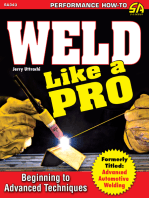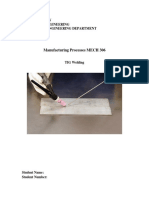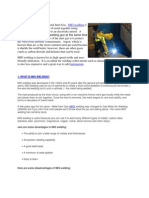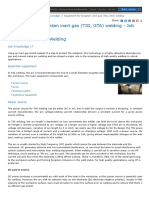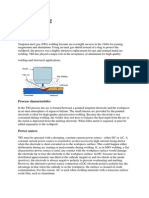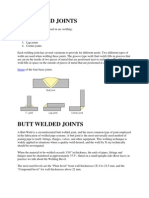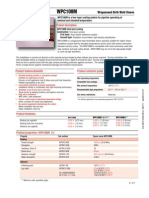TIG IT: How A TIG Welder Works and When To TIG Weld
TIG IT: How A TIG Welder Works and When To TIG Weld
Uploaded by
Hakim AzizanCopyright:
Available Formats
TIG IT: How A TIG Welder Works and When To TIG Weld
TIG IT: How A TIG Welder Works and When To TIG Weld
Uploaded by
Hakim AzizanOriginal Title
Copyright
Available Formats
Share this document
Did you find this document useful?
Is this content inappropriate?
Copyright:
Available Formats
TIG IT: How A TIG Welder Works and When To TIG Weld
TIG IT: How A TIG Welder Works and When To TIG Weld
Uploaded by
Hakim AzizanCopyright:
Available Formats
TIG IT: How a TIG Welder Works and When to TIG Weld
By Sleepy Gomez, Publisher and Technical Director, Oval Trak Digest.com First off, let's define the TIG welding process and provide some history. TIG stands for Tungsten Inert Gas and is technically called Gas Tungsten Arc Welding or GTAW. The process uses a non-consumable tungsten electrode that delivers the current to the welding arc. The tungsten and weld puddle are protected and cooled with an inert gas, typically argon. TIG welding is similar to oxy-acetylene welding in that you use a filler material for build-up or reinforcement. TIG welding is often referred to as Heli-arc welding, originating from an early Hobart "Heli-Arc" machine. The name comes from using helium gas as a shield around the electric arc. TIG welding was developed in the 1930s and was used during World War 2 as the preferred way to weld many aircraft parts. Previously, some alloy steels and aluminum had to be welded with a torch, something that required considerable skill and time. In race car fabrication, we use the TIG welding process for aluminum and 4130 chrome-moly steel. If you are going to be welding on either of these materials, you need a quality TIG welder. Miller offers products that will accommodate anyone from a home hobbyist to an advanced user. My machine of choice is the Miller Syncrowave 200. This welder has an air-cooled torch rather than a water-cooled setup. Why? Well, it is less expensive, as well as lighter. Unless you are in a production situation where you are running long welds without interruption, the air-cooled torch is quite adequate for this product. Most TIG welders will have an AC/DC switch. Use DC current for welding steels and AC current when welding aluminum. By the way, this welder can also be used for Stick welding.
If you have ever welded with an oxy-acetylene torch, then you can easily weld with a TIG machine. The TIG process uses an electric torch, where you hand feed a filler rod into the molten puddle. The ability to soft start and soft stop the heat makes the TIG process different from other types of electric welding. Some people like the accelerator pedal to control the heat if they are working on a bench and others like finger tip remotes on the torch if they are working in areas that are considered out of position. The remote adjusts the heat while you are welding. Before you use a TIG unit, you should be familiar with the parts of the welder and the function of each part. The work lead, often referred to as a ground cable with a clamp, must be attached to the work piece or to the metal surface that the work piece is on. The welding lead cable will have an electric TIG torch on the end. Along with the cable is a small line that carries
the argon gas. The inert gas performs like the flux coating on a stick electrode in that it protects the weld from air-borne contaminants. You will need a gas bottle and a regulator. DO NOT use the same gas that you would use with a MIG welder. The torch disassembles into several parts. The small tungsten rod (several sizes are available) is the electrode. This electrode does not burn up like a filler rod. The tungsten can be sharpened to a point or ball shape depending on what you are welding. A copper collet holds the tungsten and is used to adjust the length that the tungsten protrudes from the cup. The ceramic cup (usually pink) can be unscrewed and replaced as needed. Several cup outlet diameters are available. In the collet body, there are several cross-holes that allow the gas to pass into the cup and surround the tungsten. This excludes oxygen that would contaminate a weld. Loosening the back cap will reduce the collet's grip on the tungsten and allow the tungsten to be removed for sharpening or replacement. If you have never used a TIG machine, the "throttle" may seem unusual. This is a foot-operated variable amperage control. After the maximum amperage desired is pre-set on the machine, the "throttle" will allow you to vary the amperage up to the maximum pre-set amperage. This is useful when welding alloy steels, such as 4130 chrome-moly. The foot control allows you to slowly initiate the heat, and after the weld is complete you can slowly reduce the heat. This soft start and soft stop prevents temperature shocking the metal. Many alloy steels used in race cars are sensitive to thermal shock. Welding by other means may lead to brittle welds. The TIG machine itself, and I really like my Miller Syncrowave 200, has numerous controls. There is a main switch in the center that selects negative electrode (torch) for TIG welding steel, AC for welding aluminum and positive electrode for Stick welding using reverse polarity rods. This is the electric torch. It is air-cooled, making it light and easy to handle. Hold the torch in one hand and feed the rod with the other. The tungsten (T) is shielded by the inert (I) gas (G), normally argon. This gas shield is the flux that keeps oxygen from contaminating the weld by oxidizing the metal. Across the top are several buttons. On the left, select the TIG or Stick process. One of the most vital controls for welding on aluminum is the balance control, located smack dab in the middle of the controls. The balance controls the cleaning vs. penetration on aluminum. The higher the balance, the more penetration you'll get. Typical settings range from 70 to 80 percent, or 7-8. To the right you can select normal or pulse mode. When using the pulse mode on aluminum, the amperage is automatically varied in a pulse fashion. This can reduce the heat into the work piece and help you achieve a better weld, as well as reduce the heat-affected zone. Further, pulsing automatically produces "stacked dimes" or a rippled wave pattern in the weld. At the far left is a feature I particularly like, an amp control. The machine ranges from 5 to 200 amps. If I set the machine to 45 amps, that's the maximum output the machine will give me. When I'm welding something thin, I can't accidentally apply too much current through the foot pedal. It's like insurance.
These are the internal parts of the electric torch. The collet holder holds the collet on one end and a ceramic cup on the other. The collet holds and clamps the tungsten in position. The holes in the collet holder allow
Now, let's get ready to weld. The TIG process is not unlike the gas to flow around the tungsten to prevent welding with an oxy-acetylene torch. You hold the torch in one contamination of the weld. hand and feed a filler rod with the other. An auto-darkening welding hood makes starting the weld more accurate. For years I welded with a simple dark fixed-shade helmet. It must have taken me 7 or 8 seconds to adapt to the auto-darkening hood. A common available filler rod for welding aluminum is the 4043 alloy. If you are trying to color match welds on parts to be anodized, use 5356, which will match better than most others. Use a filler material guide to better match the base material to the filler material. When TIG welding steel, use a filler material, or filler rod, similar to the filler rod used in oxy-acetylene welding. It has a thin copper coating to inhibit rusting. I've been told by welding professionals that the copper coating is not detrimental to the welds even on chrome-moly. However, a non-coated filler rod is available and must be kept rust free. To start, gather up some clean metal scraps. You should have a metal top table or at least a metal plate clamped firmly to the table. You might find that welding is somewhat like sex. Your position has a lot to do with your enjoyment. Pull up a stool. Place the foot pedal within easy reach once you are seated. It is important to wear the proper protective welding gear, such as a long-sleeved shirt or coveralls, a welding helmet, and leather gloves and shoes, even when TIG welding. A ceramic cup shrouds the tungsten electrode directing the gas flow. These cups come in several sizes for different welding applications.
Set the welder to the correct polarity, which will be specified by the type of metal you are going to weld-AC for aluminum or DC for steels. Select the appropriate welding rod. Make sure the gas bottle is turned on. I set the regulator at about 20 CFH (cubic feet per hour). Check that the tungsten has the correct point for the metal you are welding. It should be sticking out of the cup by about 1/8 in. Hold the torch up, away from your body, depress and release the foot pedal. You should be able to hear the gas flow. If not then find out why. Did you turn on both the welder and the bottle? You are ready to weld. Let me explain a few TIG pitfalls to make your learning process easier. The tungsten should never touch the work piece. When it does, you will notice a different sound and color, which means the tungsten is contaminated. Loosen the back cap and slip the tungsten (it is hot) out. Go to the grinder, preferably one with a wheel dedicated to tungsten, and clean the end of the tungsten. Reshape the end as necessary. You will dip the tungsten many times as you learn, but, with more practice you'll be steadier and the less it will happen.
This is the tungsten electrode. It has been ground to a ball shape on one end and a point on the other. Each shape has its application. The tungsten is considered a consumable item and will be used up over time.
Back at the welding table, get some practice. Use different heats and different feeds of the rod on your scraps. This article won't make you a proficient TIG welder, but it should give you a good understanding of how a TIG welder works and why you might need one. A good machine, such as my Miller Syncrowave 200, has the capacity to weld up to 1/4-in. aluminum and 3/8-in. steel or stainless steel; in fact, it can do more than I ask it to do. The Syncrowave has capabilities that are beyond the reach of this article. It is not difficult to use, but it will take patience to use it properly. If you need to weld aluminum or precision weld steels, this is the way to get it done.
This is a very nice tool if you do a lot of TIG welding. Its a hand-held unit that automatically grinds. tungsten to a point.
Just the thing for race-car welders! This is a foot control for the speed (oops!), rather amperage, control of the Miller TIG machine. Though not shown, there is a thumb control available that attaches to the torch that also allows amperage control.
Part of a weld joint has been completed. Too much heat directed to the thin edge has burned a hole in the metal of this .035-in. steel tube. With the foot amperage control, the heat
Preparing to start a weld: the torch with the tungsten in place. The welding rod is ready to be added. With an auto-darkening helmet, everything can be positioned without having
can be controlled enough to repair this flaw. to shake your head to flip the hood down. With a bit of practice, this won't happen again.
The TIG welder in action. The rod is being fed with one hand while the other guides the torch. A comfortable position here means a lot to weld quality.
This is the type of weld joint you should avoid. All these tubes converged at one point and were tack welded into place. It is virtuallyimpossible to reach the inside edges of the tubes. The part should have been welded in sections that were stacked so that the last welds were properly positioned for welding.
Here the welder is using the soft stop technique. He finished the weld and slowly reduced the amperage. The gas flow remains on for a few seconds to prevent weld contamination. This technique is reversed when beginning a weld by slowly bringing the heat up. All of this prevents thermal shock, which you must prevent on chrome-moly steels.
A finished weld? No. This joint has been welded as much on the bottom as on the top. It is advantageous to weld a joint from side to side to control warpage. Turn the workpiece as necessary.
At the top of the front panel on Miller's Syncrowave 200 is what I call the wonder panel. Selections of TIG or Stick, adjustment for balance wave and the wonderful pulse. A nice feature is the amperage limiter. A dial sets the LED display at the top. When welding thin metals, this adjustment can be set to prevent an itch on your big toe from overheating the weld. All in all, this is a quality welder, from which you can turn out quality work.
You might also like
- TIG Welding HandbookDocument88 pagesTIG Welding HandbookBalakumar100% (3)
- 12 Tig WeldingDocument8 pages12 Tig WeldingSampath KumarNo ratings yet
- Weld Like a Pro: Beginning to Advanced TechniquesFrom EverandWeld Like a Pro: Beginning to Advanced TechniquesRating: 4.5 out of 5 stars4.5/5 (6)
- A Beginner's Guide To TIG WeldingDocument5 pagesA Beginner's Guide To TIG WeldingKalaimugilan ArunNo ratings yet
- TIG Welding NamesDocument20 pagesTIG Welding NamesMuhammad KhyzerNo ratings yet
- Free How To Do TIG Welding GuideDocument10 pagesFree How To Do TIG Welding Guideshotdead2002No ratings yet
- Basic TIG WeldingDocument9 pagesBasic TIG WeldingMardeOpamenNo ratings yet
- Welding Technology Unit 1 NotesDocument58 pagesWelding Technology Unit 1 NotesVasanthakumar B.E;No ratings yet
- Directional Solidification of Steel CastingsDocument59 pagesDirectional Solidification of Steel CastingsSUNDRAMNAGANo ratings yet
- 300 SS TigDocument10 pages300 SS TigSameer KhanNo ratings yet
- Best Practices For TIG Welding 1Document6 pagesBest Practices For TIG Welding 1Orlando1949No ratings yet
- Experiment - TIGDocument5 pagesExperiment - TIGAl Anood Al AmeriNo ratings yet
- Tig RwtiDocument39 pagesTig RwtiSaptarshi PalNo ratings yet
- Description of Tig Welding Final 1Document4 pagesDescription of Tig Welding Final 1api-355092514No ratings yet
- Welding MachinesDocument53 pagesWelding MachinesDeepak Kumar Kant Kesri100% (2)
- Tig Welding Tips NewDocument5 pagesTig Welding Tips NewKentDemeterioNo ratings yet
- Tig Welding Method and Application NewDocument59 pagesTig Welding Method and Application NewKentDemeterio100% (1)
- What Is MIG WeldingDocument2 pagesWhat Is MIG Weldingbrajeshme11012No ratings yet
- Amta5 8 Applying Tungsten Inert Gas Tig Welding TechniquesDocument115 pagesAmta5 8 Applying Tungsten Inert Gas Tig Welding TechniquesAbu RectifyNo ratings yet
- Manufacturing Technology: Tig Welding - Process AnalysisDocument8 pagesManufacturing Technology: Tig Welding - Process AnalysisshubhamNo ratings yet
- Getting To Know Tig WeldingDocument12 pagesGetting To Know Tig WeldingMatthew ZahraNo ratings yet
- Tig WeldingDocument29 pagesTig WeldingzahidNo ratings yet
- Welding MachineDocument3 pagesWelding MachinetuanNo ratings yet
- Applying Tig Techniques Hand-OutDocument12 pagesApplying Tig Techniques Hand-Outjuvy may esbanNo ratings yet
- Welding Cutting & Heating GuideDocument68 pagesWelding Cutting & Heating GuideKentDemeterioNo ratings yet
- 304 SsDocument54 pages304 Ssshakir ramzanNo ratings yet
- TIG Welding: Job KnowledgeDocument3 pagesTIG Welding: Job KnowledgeRakesh Kumar Munda100% (1)
- Free How To Do MIG Welding GuideDocument10 pagesFree How To Do MIG Welding GuidejhggkjghjgNo ratings yet
- PROCESS Gas Tungsten Arc Welding (GTAW)Document2 pagesPROCESS Gas Tungsten Arc Welding (GTAW)Ejaz AlamNo ratings yet
- 3 Ways To Weld Aluminum - WikiHowDocument4 pages3 Ways To Weld Aluminum - WikiHowsamardotsinghNo ratings yet
- Equipment For Tig WeldingDocument4 pagesEquipment For Tig WeldingSaeedNooriNo ratings yet
- TIG Welding TipsDocument4 pagesTIG Welding TipsEnrico959No ratings yet
- Seminar Report TIGDocument13 pagesSeminar Report TIGRahul ShawNo ratings yet
- TIG Welding of Ms Plate EXP 9Document3 pagesTIG Welding of Ms Plate EXP 9yash.parihar4472No ratings yet
- JJ205 Workshop Technology Tic&Mic WeldingDocument47 pagesJJ205 Workshop Technology Tic&Mic WeldingAh TiangNo ratings yet
- Orbital-Welding Facts enDocument52 pagesOrbital-Welding Facts ene.vicente.caballeroNo ratings yet
- 5 GtawDocument45 pages5 GtawPutra Daha PratamaNo ratings yet
- Pe EXP 9Document3 pagesPe EXP 9yash.parihar4472No ratings yet
- MIG Vs TIG Vs Stick Vs Flux Core Welding ProcessesDocument8 pagesMIG Vs TIG Vs Stick Vs Flux Core Welding ProcessesCalvin YeohNo ratings yet
- Basic Weld JointsDocument10 pagesBasic Weld JointsSham AmirNo ratings yet
- By Ayuba IsaacDocument18 pagesBy Ayuba Isaacloganathan100% (1)
- 10 Metal-OkDocument11 pages10 Metal-OkArunodha HettiarachchiNo ratings yet
- Gas Tungsten-Arc Welding GTAW - Welding TechnologyDocument2 pagesGas Tungsten-Arc Welding GTAW - Welding TechnologyMuhammadNo ratings yet
- Experiments 7Document2 pagesExperiments 7Deep SasaniNo ratings yet
- Bolted Aluminium Terminal Connectors For Substations: Material of CastingsDocument5 pagesBolted Aluminium Terminal Connectors For Substations: Material of CastingsTravis WoodNo ratings yet
- TIG Welding: Process CharacteristicsDocument3 pagesTIG Welding: Process CharacteristicsRaj BindasNo ratings yet
- ARC WeldingDocument14 pagesARC WeldingMay FadlNo ratings yet
- Analysis of Tig Welding Weldment and Defect Identification Using Non Destructive Testing NDTDocument48 pagesAnalysis of Tig Welding Weldment and Defect Identification Using Non Destructive Testing NDTRebecca KelleyNo ratings yet
- Mig Gmaw Welding 1Document26 pagesMig Gmaw Welding 1HAZEL BELLONo ratings yet
- What Is WeldingDocument9 pagesWhat Is WeldingRama Krishna Reddy DonthireddyNo ratings yet
- Mig Guide From Zero PDFDocument10 pagesMig Guide From Zero PDFHugo SalazarNo ratings yet
- TIGDocument10 pagesTIGMuhamad Irwan Ismail100% (1)
- TIG-welding Gases PDFDocument2 pagesTIG-welding Gases PDFwenigmaNo ratings yet
- Lecture 8 Tig WeldingDocument24 pagesLecture 8 Tig Weldinghoseahosea2001No ratings yet
- Welding Tips & Tricks: All you need to know about welding machines, welding helmets, and welding gogglesFrom EverandWelding Tips & Tricks: All you need to know about welding machines, welding helmets, and welding gogglesRating: 1 out of 5 stars1/5 (1)
- Bolted Flanged Joint: Flanges, Studs & Gaskets. Recommended Practices for the Assembly of a Bolted Flange Joint.From EverandBolted Flanged Joint: Flanges, Studs & Gaskets. Recommended Practices for the Assembly of a Bolted Flange Joint.No ratings yet
- Soldering Electronic Components 2nd EditionFrom EverandSoldering Electronic Components 2nd EditionRating: 3 out of 5 stars3/5 (2)
- Autotorq Hydraulic Chain Pipe Wrench Operation ManualDocument20 pagesAutotorq Hydraulic Chain Pipe Wrench Operation Manualjlhunter70No ratings yet
- Civil Engineering AbbreviationDocument3 pagesCivil Engineering AbbreviationVincent TayagNo ratings yet
- Mechanical Solar Tracker - BOMDocument7 pagesMechanical Solar Tracker - BOMDeepak MisraNo ratings yet
- Plumbing & Water Isometric ViewDocument1 pagePlumbing & Water Isometric ViewAntonio EstradaNo ratings yet
- GP Sheet Stock HosurDocument4 pagesGP Sheet Stock HosurSURANA1973No ratings yet
- Application FormDocument99 pagesApplication FormFarly Vergel100% (1)
- Asme SB-283 C37700Document1 pageAsme SB-283 C37700Don AskmeNo ratings yet
- PCI Standard Design PracticeDocument17 pagesPCI Standard Design Practicerodrigo.macedoNo ratings yet
- Branch JointDocument2 pagesBranch Jointskipina74No ratings yet
- Inlook Partition Wall SystemsDocument36 pagesInlook Partition Wall SystemsJoseph Cloyd LamberteNo ratings yet
- ValveCat HandValvesDocument4 pagesValveCat HandValvesClaudio Israel Godinez SomeraNo ratings yet
- FAIDocument14 pagesFAIalejandroruiz020697No ratings yet
- Request For PO FormDocument4 pagesRequest For PO FormRodel Dela Cruz Natividad Jr.No ratings yet
- Covalence WPC100M Shrink Sleeves PDFDocument2 pagesCovalence WPC100M Shrink Sleeves PDFJMROMANTNo ratings yet
- Adi 1. Definisi Dan Penggunaan PipaDocument19 pagesAdi 1. Definisi Dan Penggunaan PipaRahestya Kusuma AuraNo ratings yet
- Base Plate & Anchor Bolt Design For Pipe Dia 508 Loading DetailsDocument4 pagesBase Plate & Anchor Bolt Design For Pipe Dia 508 Loading DetailsAsaru DeenNo ratings yet
- Plastic Pipe System - CatalogDocument36 pagesPlastic Pipe System - CatalogAlinda Gupta AbhroNo ratings yet
- Cosasco Severe Service Access Fitting AssembliesDocument2 pagesCosasco Severe Service Access Fitting AssembliesEdgar I RamirezNo ratings yet
- Revised Kisan PVC Fitt. Pricelist For RAJ - Jul 2021Document8 pagesRevised Kisan PVC Fitt. Pricelist For RAJ - Jul 2021Amit AgrawalNo ratings yet
- Type of Monolithic Refractories PDFDocument4 pagesType of Monolithic Refractories PDFNaelNo ratings yet
- Lec 14 Highway EngineeringDocument37 pagesLec 14 Highway EngineeringKamaluddin KamalNo ratings yet
- SECTION 05500 Metal FabricationsDocument7 pagesSECTION 05500 Metal FabricationsJohanesTangdiNo ratings yet
- SIST EN 573-1 - 2005 - Aluminium and Aluminium Alloys-Chemical Composition and Form of Wrought Products. Part1-Numerical Designation SystemDocument9 pagesSIST EN 573-1 - 2005 - Aluminium and Aluminium Alloys-Chemical Composition and Form of Wrought Products. Part1-Numerical Designation SystemAlvaroNo ratings yet
- UNIT I Polymer TechnologyDocument30 pagesUNIT I Polymer TechnologyAdi KothaNo ratings yet
- TALAT Lecture 5205: Plating On AluminiumDocument19 pagesTALAT Lecture 5205: Plating On AluminiumCORE Materials100% (1)
- Pattern Making AssignmentDocument5 pagesPattern Making AssignmentDiyaNegiNo ratings yet
- of Centrifugal Casting ProcessDocument14 pagesof Centrifugal Casting Processakshay sawansukha100% (1)
- Rate Book - 2011-NCP Building DPTDocument244 pagesRate Book - 2011-NCP Building DPTthak_raj84No ratings yet
- Columns DetailsDocument1 pageColumns DetailsJoseph DamianNo ratings yet


